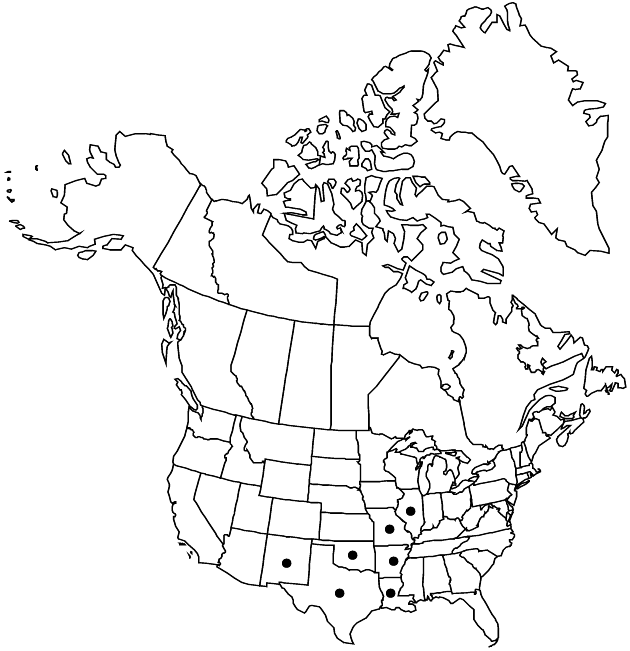Difference between revisions of "Gutierrezia texana"
Fl. N. Amer. 2: 194. 1842.
FNA>Volume Importer |
RevisionBot (talk | contribs) m (Bot: Adding category Revised Since Print) |
||
| (6 intermediate revisions by 4 users not shown) | |||
| Line 11: | Line 11: | ||
|name=Hemiachyris texana | |name=Hemiachyris texana | ||
|authority=de Candolle | |authority=de Candolle | ||
| + | |rank=species | ||
|publication_title=in A. P. de Candolle and A. L. P. P. de Candolle, Prodr. | |publication_title=in A. P. de Candolle and A. L. P. P. de Candolle, Prodr. | ||
|publication_place=5: 314. 1836 | |publication_place=5: 314. 1836 | ||
| Line 17: | Line 18: | ||
|name=Xanthocephalum texanum | |name=Xanthocephalum texanum | ||
|authority=(de Candolle) Shinners | |authority=(de Candolle) Shinners | ||
| + | |rank=species | ||
}} | }} | ||
|hierarchy=Asteraceae;Asteraceae tribe Astereae;Gutierrezia;Gutierrezia texana | |hierarchy=Asteraceae;Asteraceae tribe Astereae;Gutierrezia;Gutierrezia texana | ||
| Line 25: | Line 27: | ||
}}<!-- | }}<!-- | ||
| − | --><span class="statement" id="st-undefined" data-properties=""><b>Annuals,</b> 10–80(–100) cm. <b>Stems</b> glabrous. <b>Leaves</b>: proximal usually absent at flowering; cauline blades 1- or 3-nerved, linear, 1.5–4 mm wide, reduced distally. <b>Heads</b> in loose arrays. <b>Involucres</b> campanulate to obconic, 2–4.5 mm diam.. <b>Phyllary</b> apices flat. <b>Ray</b> florets 5–23; corollas yellow, 3–6 mm. <b>Disc</b> florets 7–48 (bisexual and fertile or functionally staminate). <b>Cypselae</b> 1.3–1.8 mm, faces without oil cavities, loosely strigose (hairs appressed, apices acute, microscopically 2-pronged); pappi of 1 series of spreading-erect, oblong to ovate or obovate scales 0.1–0.5 mm (bases sometimes connate, usually shorter in rays, sometimes 0 in < | + | --><span class="statement" id="st-undefined" data-properties=""><b>Annuals,</b> 10–80(–100) cm. <b>Stems</b> glabrous. <b>Leaves</b>: proximal usually absent at flowering; cauline blades 1- or 3-nerved, linear, 1.5–4 mm wide, reduced distally. <b>Heads</b> in loose arrays. <b>Involucres</b> campanulate to obconic, 2–4.5 mm diam.. <b>Phyllary</b> apices flat. <b>Ray</b> florets 5–23; corollas yellow, 3–6 mm. <b>Disc</b> florets 7–48 (bisexual and fertile or functionally staminate). <b>Cypselae</b> 1.3–1.8 mm, faces without oil cavities, loosely strigose (hairs appressed, apices acute, microscopically 2-pronged); pappi of 1 series of spreading-erect, oblong to ovate or obovate scales 0.1–0.5 mm (bases sometimes connate, usually shorter in rays, sometimes 0 in <i></i>var.<i> texana</i>).</span><!-- |
-->{{Treatment/Body | -->{{Treatment/Body | ||
| − | |distribution= | + | |distribution=Ark.;Ill.;La.;Mo.;N.Mex.;Okla.;Tex.;Mexico. |
|discussion=<p>Varieties 2 (2 in the flora).</p><!-- | |discussion=<p>Varieties 2 (2 in the flora).</p><!-- | ||
--><p>Although the two varieties of <i>Gutierrezia texana</i> are similar, the geographic demarcation between them appears to be sharp, and a detailed investigation of their biologic interaction would be interesting.</p> | --><p>Although the two varieties of <i>Gutierrezia texana</i> are similar, the geographic demarcation between them appears to be sharp, and a detailed investigation of their biologic interaction would be interesting.</p> | ||
| Line 46: | Line 48: | ||
|-id=key-0-1 | |-id=key-0-1 | ||
|1 | |1 | ||
| − | |Involucres 2–3 mm diam.; disc florets 7–13; cypselae sparsely and evenly strigose, hairs not obscuring cypsela faces; pappi of continuous or scaly crowns less than 0.1 mm | + | |Involucres 2–3 mm diam.; disc florets 7–13; cypselae sparsely and evenly strigose, hairs not obscuring cypsela faces; pappi of continuous or scaly crowns less than 0.1 mm |
| − | + | |[[Gutierrezia texana var. texana|Gutierrezia texana var. texana]] | |
|} | |} | ||
</div></div><!-- | </div></div><!-- | ||
| Line 53: | Line 55: | ||
-->{{#Taxon: | -->{{#Taxon: | ||
name=Gutierrezia texana | name=Gutierrezia texana | ||
| − | |||
|authority=(de Candolle) Torrey & A. Gray | |authority=(de Candolle) Torrey & A. Gray | ||
|rank=species | |rank=species | ||
| Line 60: | Line 61: | ||
|basionyms=Hemiachyris texana | |basionyms=Hemiachyris texana | ||
|family=Asteraceae | |family=Asteraceae | ||
| − | |distribution= | + | |distribution=Ark.;Ill.;La.;Mo.;N.Mex.;Okla.;Tex.;Mexico. |
|reference=None | |reference=None | ||
|publication title=Fl. N. Amer. | |publication title=Fl. N. Amer. | ||
|publication year=1842 | |publication year=1842 | ||
|special status= | |special status= | ||
| − | |source xml=https:// | + | |source xml=https://bitbucket.org/aafc-mbb/fna-data-curation/src/2e0870ddd59836b60bcf96646a41e87ea5a5943a/coarse_grained_fna_xml/V19-20-21/V20_173.xml |
|tribe=Asteraceae tribe Astereae | |tribe=Asteraceae tribe Astereae | ||
|genus=Gutierrezia | |genus=Gutierrezia | ||
| Line 71: | Line 72: | ||
}}<!-- | }}<!-- | ||
| − | -->[[Category:Treatment]][[Category:Gutierrezia]] | + | --> |
| + | |||
| + | [[Category:Treatment]] | ||
| + | [[Category:Gutierrezia]] | ||
| + | [[Category:Revised Since Print]] | ||
Latest revision as of 19:27, 6 November 2020
Annuals, 10–80(–100) cm. Stems glabrous. Leaves: proximal usually absent at flowering; cauline blades 1- or 3-nerved, linear, 1.5–4 mm wide, reduced distally. Heads in loose arrays. Involucres campanulate to obconic, 2–4.5 mm diam.. Phyllary apices flat. Ray florets 5–23; corollas yellow, 3–6 mm. Disc florets 7–48 (bisexual and fertile or functionally staminate). Cypselae 1.3–1.8 mm, faces without oil cavities, loosely strigose (hairs appressed, apices acute, microscopically 2-pronged); pappi of 1 series of spreading-erect, oblong to ovate or obovate scales 0.1–0.5 mm (bases sometimes connate, usually shorter in rays, sometimes 0 in var. texana).
Distribution

Ark., Ill., La., Mo., N.Mex., Okla., Tex., Mexico.
Discussion
Varieties 2 (2 in the flora).
Although the two varieties of Gutierrezia texana are similar, the geographic demarcation between them appears to be sharp, and a detailed investigation of their biologic interaction would be interesting.
Selected References
None.
Key
| 1 | Involucres (2–)3.5–4.5 mm diam.; disc florets 10–48; cypselae moderately to densely strigoso-sericeous, hairs usually in dense lines and at least partially obscuring faces; pappi of distinct scales 0.2–0.5 mm, rarely more reduced | Gutierrezia texana var. glutinosa |
| 1 | Involucres 2–3 mm diam.; disc florets 7–13; cypselae sparsely and evenly strigose, hairs not obscuring cypsela faces; pappi of continuous or scaly crowns less than 0.1 mm | Gutierrezia texana var. texana |